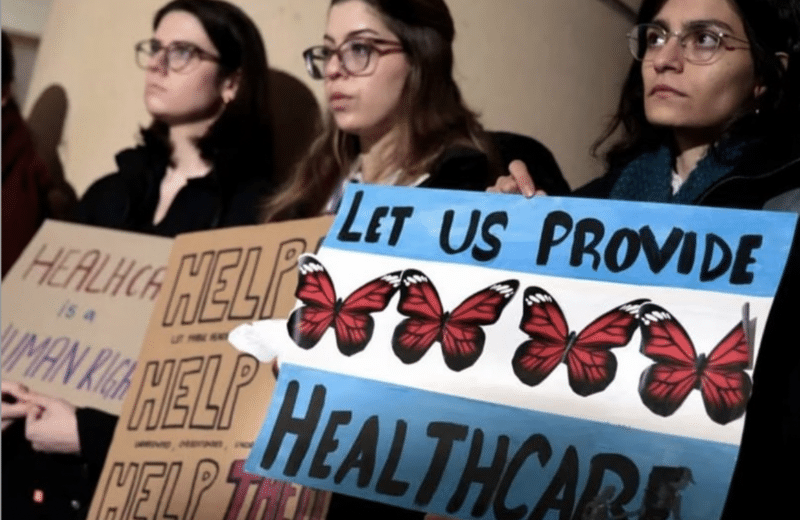How Covid-19 created a wave of eating disorders among America’s youth
From age 12 to 25, Mackenzie Carmichael felt controlled by the food she both ate and didn’t eat. At 24, after denying her eating disorder (ED) for years, she hit her version of rock bottom and went through inpatient treatment after her friends held an intervention. Carmichael ended up at the Eating Recovery Center, diagnosed with anorexia and orthorexia.
“My ED made me feel powerful, in control, and the thought of losing it scared me more than anything,” Carmichael says. “I didn’t know who I’d be without it, so it became my identity.”
In the years since the Covid-19 pandemic began, eating disorders have increased significantly. Researchers have linked this trend with increased stress, loneliness, a lack of control over daily life and routine, greater access to food, and more time spent on social media.
Studies suggest that the lifetime prevalence of eating disorders among women in the U.S. ranges from 9% to 15%, according to Timberline Knolls, an eating disorder treatment center in Lemont, Illinois. Between January 2020, shortly before the pandemic, and January 2021, there was an alarming rise in admissions and helpline calls for eating disorders, associated with a rise in the number of children waiting for treatment. Some 40% more required treatment than in previous years, according to a 2022 study published in the Journal of the American Medical Association.
To meet the need, treatment centers such as the Eating Recovery Center have increased the number of patients they can accept.
“We’ve added a combined 88 beds for child and adolescent residential treatment in our centers across the country, as well as added capacity for at least 28 more patients in partial hospitalization programs,” says Ellen Astrachan-Fletcher, PhD, Midwest regional clinical director for the Eating Recovery Center, based in Chicago.“Some of this capacity was switched from adult treatment to child and adolescent treatment because the need has been so high, particularly for young people.”
Covid’s unseen effects
The National Eating Disorders Association and the Crisis Text Line report that hospitalizations relating to eating disorders, overall helpline volume, and the percentage of eating disorder and body-image conversations have increased over the past two years.
Astrachan-Fletcher says she sees the increase in waitlists and demand for treatment. “Those who have been more socially isolated, especially since the pandemic, have been able to silently stay out of the awareness of loved ones, and therefore their struggles have been hidden,” she says.

Astrachan-Fletcher and Bentley both note the common triggers: increased family conflict due to isolating at home during the pandemic; prolonged anxiety and trauma due to the pandemic; and an increase in eating disorder symptoms influenced by social media, likely related to people spending a lot more time on social platforms during the pandemic.
While quarantine was key to avoiding Covid-19, it also enabled the privacy to go deeper into an eating disorder. Grief after losing a loved one or a sense of loss of pre-pandemic freedom created additional triggers.
“People can respond to these triggers by engaging in any variety of eating disorder behaviors including but not limited to restriction of food intake, binge eating, purging, laxative use, excessive exercise, body checking, or body avoidance,” Bentley says.
Providers are reporting more cases of eating disorders, and more extreme cases as well.
“We’re seeing so many cases, and these children and adolescents and even adults are coming in much more ill than they used to. It just doesn’t seem to be ending,” says Anna Tanner, MD, vice president of child and adolescent medicine for specialty eating disorder treatment programs at Veritas Collaborative and The Emily Program. “It is hard to know that there are many people out there struggling.”
Increased willingness to seek help
If there’s any upside to the Covid-19 years, it seems to be the growing awareness around mental health issues, including eating disorders. Many people are more willing to self-advocate for their needs.
Jillian Lampert, PhD, chief strategy officer at The Emily Program and Veritas Collaborative, says the past few years triggered new levels of self-awareness. “I think [there were many] suffering from conditions of eating disorders before Covid that weren’t getting care. Stigma [and] lack of awareness was keeping them from reaching out for health help,” she says. “Covid now has sort of unleashed the ‘now I can ask for help’, so there’s more people who needed care that weren’t getting it before.”
Bentley stresses the importance of seeking support as soon as possible. “This can be therapy, a support group, or talking to a trusted friend or family member. From there, it is important to acknowledge the existence of the eating disorder, what behaviors are involved, and begin to explore the function of those behaviors.”
Tanner’s biggest piece of advice to loved ones of those who are struggling: Find opportunities to connect in ways that are healthy and in-person. “Help [people] move forward with their life and their life goals where they’re acquiring experiences and acquiring skills — all those things that adolescents should be doing,” she says.
Lampert sees a silver lining in Covid-19’s surging eating disorder rates. “If you can say something positive came out of this really terrible experience that we went through together as a society and as a world, the awareness gained, I think, will be a game changer,” she says. “We really started to shift the stigma on mental health, needing help, and reaching out for help. People are now more comfortable talking about it.”
Carmichael counts herself as one of them. She successfully went through the entire treatment process at the Eating Recovery Center and developed a passion for health and wellness, sharing her story to encourage those who need to hear it. Her recovery helped her regain her happiness and sense of control over her life; she now lives in Chicago and works in branding.
“My time at Eating Recovery Center was the hardest, most rewarding I’ve ever experienced. Because I fully accepted my circumstance and trusted the process, I was able to beat a 15-year-long history with anorexia, orthorexia, and compulsive exercising,” Carmichael says. “Now, I am back to my happy, bubbly, optimistic, spontaneous self — and healthier than ever, thank goodness. I have sustained recovery for over three years now and am never going back.”
Originally published in the Spring/Summer 2023 print issue.












